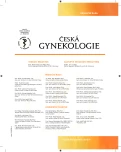Severe ovarian hyperstimulation syndrome – case study
Authors:
M. Pokorná
Authors‘ workplace:
Gynekologicko-porodnické oddělení Oblastní nemocnice, Kolín
primář MUDr. A. Toman, MBA
Published in:
Ceska Gynekol 2015; 80(6): 447-450
Overview
Objective:
To draw attention to the issue and the need of interdisciplinary cooperation in treating severe ovarian hyperstimulation syndrome (OHSS).
Design:
Case study.
Setting:
Department of Obstetrics and Gynecology, Hospital Kolín.
Case report:
We report a case of a patient after embryotransfer that is hospitalized with a diagnosis of late severe OHSS. During the treatment when her condition is accompained by voluminous ascites, disseminated intravascular coagulation and elevated liver enzymes, it is necessary to cooperate with doctors of different specialization – anestetist, hematologist, internist.
Conclusion:
Severe OHSS is a rare but serious complication of IVF treatment that due to a high number of IVF cycles is a diagnosis which every gynecologist could be confronted with. Event that numerous methods on how to prevent this condition are known these days, it is necessary not to underestimate it and to treat it thoroughly and in interdisciplinary cooperation.
Keywords:
ovarian hyperstimulation syndrom, ultrasonography, ascites, pleural effusions
Sources
1. Calda, P., Břešták, M., Fischerová, D. Ultrazvuková diagnostika v těhotenství a gynekologii, 2. vyd. Praha: Aprofema, 2010,s. 411–413.
2. Cibula, D., Stárka, L., Vrbíková, J. Syndrom polycystických ovarií. Praha: Maxdorf, 2004, s. 80–85.
3. Corbett, S., Shmougun, D., Claman, P. The prevention of ovarian hyperstimulation syndrome. Obstet Gyneacol Can, 2014, 36, 11, p. 1024–1036.
4. Gautman, N., Rubina, M. Intrauterine insemination. New Dihli, India: Jaypee Brothers Medical Publishers, 2014, p. 126,
https://books.google.cz/books?id=9e28AQAAQBAJ&printsec=frontcover&hl=cs&source=gbs_ge_summary_r&cad=0#v=onepage&q&f=false
5. Hudeček, R., Huser, M., Ventruba, P. Rizikové faktory vzniku ovariálního hyperstimulačního syndromu v programu asistované reprodukce. Prakt Gyn, 2004, 4, s. 6–10.
6. Institute of Obstetricians and Gynaecologists Royal College of Physicians of Ireland, Clinical practice guideline – Ovarian hyperstimulation syndrom (OHSS) Diagnosis and management, 2012, http://www.hse.ie/eng/about/Who/clinical/natclinprog/obsandgynaeprogramme/guide8.pdf.
7. Kolařík, D., Halaška, M., Feyereisl, J. Repetitorium gynekologie, 2. rozšířené vyd. Praha: Maxdorf, 2011, s. 485–490.
8. Machač, Š., Procházka, M., Lubušký, M. Prevalence vrozených trombofilií u pacientek s těžkou formou ovariálního hyperstimulačního syndromu. Prakt Gyn, 2007, 11, 3, s. 77–80.
9. Mardešič, T. Kde je a kam směřuje asistovaná reprodukce. Actual Gyn, 2013, 5, s. 25–26.
10. Marek, D., Machač, Š. Ovariální hyperstimulační syndrom – soubor interních komplikací u gynekologických pacientek podstupující in vitro fertilizaci. Interní medicína pro praxi, 2003, 8,s. 389–393.
11. Pařízek, A. Kritické stavy v porodnictví. Praha: Galén, 2012,s. 271–273.
12. Rob, L., Martan, A., Cittebart, K. Gynekologie, 2. vyd. Praha: Galén, 2008, s. 174–178.
13. Řežábek, K. Asistovaná reprodukce. Praha: Maxdorf, 2008,s. 80–83.
14. Smith, V., Osianlis, T., Vollenhoven, B. Prevention of ovarian hyperstimulation syndrom: a review. Obstet Gynecology Inter, 2015, http://www.ncbi.nlm.nih.gov/pmc/articles/PMC4446511/.
15. Středa, R., Koryntová, D., Mardešič, T. Prokázané klinické účinky rekombinantních gonadotropinů v porovnání s urinárními v indukci ovulace, Čes Gynek, 2011, 76, 2, s. 108–113.
16. Yahia El-Faissal. Approaches to complete prevention of OHSS. Middle East Fertility Society J, 2014, 19, p. 13–15.
Labels
Paediatric gynaecology Gynaecology and obstetrics Reproduction medicineArticle was published in
Czech Gynaecology

2015 Issue 6
Most read in this issue
- Severe ovarian hyperstimulation syndrome – case study
- Medical termination of pregnancy by mifepristone and misoprostol – evaluation of succes rate, complications and satisfaction of patients
- Thrombophilia in pregnacy
- Hyperthyroidism in pregnancy, less common disorder of the thyroid gland complicating the pregnancy
